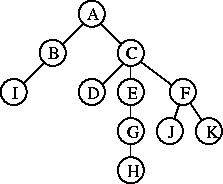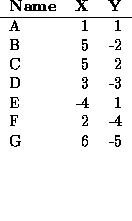For each of the following requirements on a list representation, which would be the best implementation scheme (chose from sequential storage, linked list, or doubly linked list).
- you need to frequently insert and delete items anywhere in the list.
- you need to insert or delete items 2 or 3 spaces before or after a given item.
- you need to access random items in the list.
Given the sequence of operations: insert A, insert B, delete, Insert C, insert D, delete. Which of the following data structures can produce the results shown (choices are stack, queue, or input restricted deque
- B C
- A C
- C D
Consider the following tree:

- Write the preorder traversal for this tree.
- Write the postorder traversal for this tree.
- Represent the tree as a binary tree, using the transformation scheme discussed in class.
- Is the preorder traversal for the converted binary tree the same as for the original tree?
- Is the postorder traversal the same?
(A B 3) (A C 8) (B D 2) (B E 6) (C F 7) (C D 2) (D F 2) (E F 4)
- that a graph of n nodes and less than n-1 edges is not connected ( n>1 ).
- that a graph of n nodes with n or more edges has a cycle ( n>2 ).
(defun mystery (list1 list2)
(cond ((null list1) list2)
((null list2) list1)
(t (cons (car list1)
(cons (car list2)
(mystery (cdr list1) (cdr list2)))))))
- In English, what does mystery do?
- what is the result of the following call:
(mystery '(1 2 3 4) '(a b c)) - Draw the cons cells created in the following call:
(setq X (mystery (list 1 3 5 6) (list 2 4))) - assuming X is the only immediately accessible pointer, mark the accessible cons cells and tell how many are now garbage.
Now consider the following sequence of memory allocation requests: 500, 600, 500, 400.
- What will the remaining free list be according to the first-fit algorithm?
- What will be the remaining free list according to the best-fit algorithm?
1 12 3 8 4 9
5 4 1 9 2 8 6 7 3
mergesort which takes an
arbitrary list of numbers and returns a sorted list by calling the
second: mergelists which takes two sorted lists and returns
one sorted list containing all of the elements of each list. You can
also assume the functions firsthalf which takes a list of n
items and returns a list containing the first secondhalf which takes a list of n items and returns a list
containing the last 